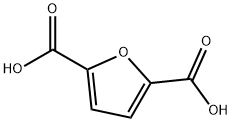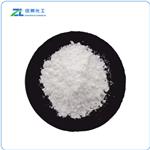Description
2,5-Furandicarboxylic acid (FDCA) is an organic chemical compound consisting of two carboxylic acid groups attached to a central furan ring. It was first reported as dehydromucic acid by Rudolph Fittig and Heinzelmann in 1876, who produced it via the action of concentrated hydrobromic acid upon mucic acid. It can be produced from certain carbohydrates and as such is a renewable resource, it was identified by the US Department of Energy as one of 12 priority chemicals for establishing the “green” chemistry industry of the future.Furan-2,5-dicarboxylic acid (FDCA) has been suggested as an important renewable building block because it can substitute for terephthalic acid (PTA) in the production of polyesters and other current polymers containing an aromatic moiety.
wikipedia
Chemical Properties
2,5-Furandicarboxylic acid is a chemical intermediate with high sensitivity and good stability. It is soluble in water under alkaline conditions and is a white powder solid under acidic conditions, and is an important monomer for the preparation of corrosion-resistant plastics. It is irritating to eyes, respiratory tract and skin.
History
2,5-Furandicarboxylic acid, also known as dehydromucic acid, is a furan derivative. This organic compound was first obtained by Fittig and Heinzelmann in 1876. More than 125 years later, FDCA was identified by the US Department of Energy as one of 12 priority chemicals for establishing the "green" chemistry industry of the future. On a laboratory scale, it is often synthesized from 5- hydroxymethylfurfural (HMF), which in turn can be obtained from carbohydrate-containing sources such as glucose, fructose, sucrose, and starch. From fructose and glucose, HMF is obtained by acidic eliminating three moles of water.
Uses
2,5-Furandicarboxylic acid (FDCA) is a renewable, greener substitute for terephthalate in the production of polyesters. It is widely used as a precursor for the synthesis of bio-based polyesters and various other polymers.
Applications of FDCA in the synthesis of several metal-organic frameworks (MOFs) have also been reported.
Uses
Interest in renewable based polymers has led to 2,5-furandicarboxylic acid being proposed as a green, sustainable alternative to the widely used petroleum-based terephthalic acid in the synthesis of polyesters. 2,5-Furandicarboxylic acid is produced from oxidation of 5-hydroxymethylfurfural (HMF) which is obtained from the dehydration of bio-based sugars such as fructose.
Definition
ChEBI: A member of the class of furans carrying two carboxy substituents at positions 2 and 5.
Application
2,5-Furandicarboxylic acid (FDCA) is a renewable, greener substitute for terephthalate in the production of polyesters. It is widely used as a precursor for the synthesis of bio-based polyesters and various other polymers.
Applications of FDCA in the synthesis of several metal-organic frameworks (MOFs) have also been reported.
Flammability and Explosibility
Not classified
Solubility in organics
2,5-Furandicarboxylic acid (FDCA) serves as a monomer in various polyesters and is often obtained through the oxidation of 5-hydroxymethylfurfural. In pure solvents and binary mixtures, the solubility of FDCA increased with the increasing temperature. The order from largest to smallest solubility in pure solvents was as follows: methanol, 1-butanol, isobutanol, acetic acid, water, MIBK, ethyl acetate, and acetonitrile.
https://doi.org/10.1021/acs.jced.7b00927





